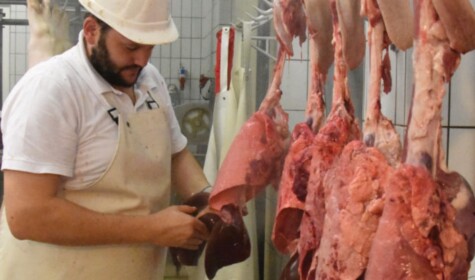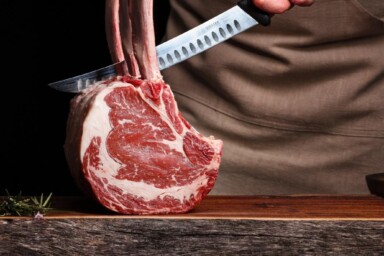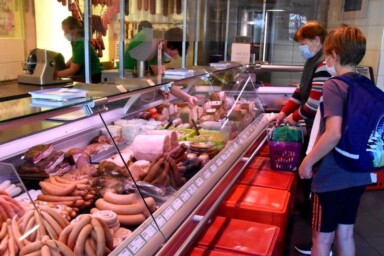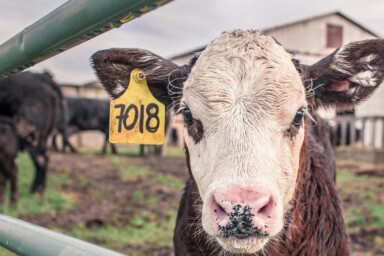Marianne Landzettel has been looking at sustainable agricultural systems and relocalised food production in her native Germany. This is the first part of a detailed examination of a small abattoir and how it works, how they offer improved animal welfare and how the meat that it produces feeds a thriving local economy.
Please note that the piece includes a detailed description of the process of slaughter.
Legau is a small town (population 3,300) in southern Germany, about 20 kilometres south of Memmingen or, as the crow flies, 60 kilometres north of the eastern tip of Lake Constance and 140 kilometres west of Munich. To some this may sound as if Legau were in the middle of nowhere; to those living there, Legau is a small market town in the middle of the Allgäu, one of the most picturesque regions in Germany.
Pick up any tourist brochure and the Allgäu region will likely feature: it’s a rural idyll with small towns and villages, houses adorned with flower boxes and hanging baskets and the pastures on the soft rolling hills are lush and green. Brown Swiss cows slowly graze, chewing their cud, and if the weather is right, you can often make out the snow-covered peaks of the Alps in the distance. It’s quite a picture.
Part of the Allgäu belongs to the state of Baden Württemberg and part to Bavaria, which is where Legau is situated – a technicality that matters, because in Germany, states have a lot of leeway in regards to veterinary regulations and requirements, not just when it comes to slaughter.
The Legau abattoir is not sign posted, and the night before we are scheduled to visit, we’ve met up with Rainer Waizenegger. He is an organic dairy farmer in Legau and has been one of the directors of the farmers’ association ‘Bauerngemeinschaft Illerwinkel’ which has been running the abattoir since it was founded in the late 1990s.
Together, with two of the butchers, Klaus Steinhaus and Thomas Kling, the three make up the board of directors of the farmers’ association and the limited company (100% association owned) that runs the abattoir and the associated butchery and shop. Animals are slaughtered every Tuesday and Friday morning and within a week, the butchers have processed all meat into cuts, turned it into charcuterie such as hams and salami or one of the many different types of German sausages to be eaten hot or cold.
How a small abattoir works
The abattoir is just outside of Legau, slightly set back from the road. Rainer Waizenegger has given us directions and we check out the building – you do want to know where you are going at 4 am. But the next morning we have no problem finding the facility – it’s the only building with lights on for miles. Patches of ground fog cover the pastures and the early autumn sky is clear, with the starlight strong enough to illuminate the quiet landscape around us. Then, Klaus Steinhaus, the master butcher, pulls up in his car and takes us inside where his two colleagues are already getting changed. Steinhaus is 35-years-old, tall and lanky, with a big welcoming smile.
This Friday is a typical day for the butchers; five pigs and a piglet, a cow and two calves are scheduled for slaughter this morning. A veterinarian has inspected the animals the day before and will come to the abattoir around 6 am. The pigs have spent the night at the facility, the cow and calves will be delivered this morning.
We step into the abattoir, a white tiled room with a high ceiling and a gate at one end, wide enough to have a lorry dock here. To the left is an entrance for the animals to be led in. Just outside are two pens with deep straw bedding for animals to wait in and recover from their (short) journey.
The pigs have already been led inside. Steinhaus starts with the piglet, he places electric paddles on the side of its head and stuns it. (In an abattoir, animals are rendered unconscious through stunning – with electricity, through a shot from a bolt gun or with gas). Suspended from a rail on the ceiling are long chains with a hook at the end. With just a few moves, Steinhaus has the piglet hooked up by one of its hind legs and with the help of the chain, it can now be easily pulled up and moved to the side. A bucket is placed under the head, before his colleague cuts the piglet’s throat.
The other pigs hardly seem to notice what is happening. One by one they are stunned and bled out. It takes no more than about 10 minutes until five large and one small carcass are hanging from the ceiling rail.
Next, each pig is placed in a lidded dehairing tank for scalding; the remaining hairs are then singed off with a blowtorch. The eyes, the thymus gland, part of the ears and the horned part of the feet are removed with a knife. Once this is done, Steinhaus and his colleague hook up each carcass by the hind legs and move it towards the back of the room, where Thomas Kling opens the belly along the midline. The intestines and some of the organs are placed in stainless steel buckets and will be disposed of later, as waste. The intestines could be cleaned and used as sausage skins, but the cleaning process is long, arduous and, financially, not worthwhile. On this occasion, the animals’ blood was also considered waste, but whenever there is demand for ‘Blutwurst’, the German version of black pudding, the blood is captured in a steel basin and taken to the butchery for processing.
Next Kling removes tongue, lungs, heart and liver, all in one piece, and carefully places them on a wall rack where the vet will soon inspect them. He then removes fat from the underbelly which could be made into lard for baking, but it’s early September, too warm still for customers to buy lard, which is only in demand during the cold season. Before he pulls out the spinal cord, Kling makes sure there are no remnants of glands, and the gall bladder has been properly removed. Once the whole cavity is clean, he uses a cleaver and chainsaw to cut the carcass down the length of the spine and then moves the halves along the rails into the cooling store in the adjacent room. By the time he is done, the next pig has been dehaired and is ready for Kling.
Doing the work with two butchers is possible, but a team of three butchers is ideal, says Steinhaus. Who does which job is decided on the day, and, if need be, positions can be swapped as each member of the team is trained to perform every task – from killing the animal and dealing with the carcass in the abattoir, right through to preparing meat cuts, charcuterie and sausages in the butchery. Out of their 40-hour work week, the process of killing animals takes only a tiny fraction.
Compare this to a big slaughter facility, where this will be done on the ‘kill floor’: a number of workers will do nothing but stun animals or slit their throats to bleed them out. The carcasses will then move along an assembly line with every worker doing one job only, often reduced to a single movement. He or she will repeat that one movement every few seconds throughout the working day.
Butchery
Both Kling and Steinhaus say that while they deal with the carcass, they get a feel for the quality of the meat and that will influence their decision on how to use it – is it ideal for a big roast, should a piece be cured or cooked or best used in a particular type of sausage? ‘We are producing high quality food that tastes great and we do it from start to finish,’ says Steinhaus.
It’s 5.30 am and a farmer has arrived, delivering a seven-year-old dairy cow for slaughter. It’s blindfolded with a large piece of colourful cloth. The farmer leads the cow into the abattoir, gently talking to it. Steinhaus walks behind and as soon as the cow stands still, he moves up, places the bolt gun to its head and the animal breaks down – the whole process is over almost before I realise what’s happening. Within seconds, the butchers have the animal winched up by a hind leg, cut its throat and are waiting for it to bleed out. Next, the hide is removed. When the cow is cut open, its stomachs fill a whole wheelbarrow, most of it is a bright green mass of semi-digested grass. This cow was grazing just hours before she was slaughtered.
I step outside to have a chat with the farmer. Achim Ritter initially trained as a chef, he then took over the running of the family’s dairy farm. He regularly brings a calf or a cow for slaughter because he sells the meat online. There had always been customers who wanted to buy 10 kg mixed meat boxes, but ‘since COVID-19 the demand has gone crazy,’ says Ritter. He will return to the abattoir in a few days and collect the meat of his cow, cut into large chunks – he will do the actual butchering himself on the farm. The meat of a seven-year-old cow would normally be dog food or ground for hamburgers, at best. Not his cows, says Ritter, ‘As a chef, I know how to prepare and tenderise meat. We will sell steaks and roasts from this animal and customers will come back for more.’
Animal Welfare
While we are talking, another farmer has arrived and unloaded two calves which are now waiting in the pen next to the entrance of the abattoir. Bruno Fleck has come with his two sons, Emil, aged 13, and 11-year-old Pius; both wanted to be there as their favourite calves were delivered for slaughter. They take turns standing next to the pen, talking softly to the animals and stroking them. Emil’s calf is called Stadi; Pius has named his ‘Bauer Hermann’ (‘farmer Hermann’). Bruno Fleck is a Demeter certified dairy farmer, and he, too, sells meat directly. In a year, he brings 15-20 calves and two to five cows for slaughter. There are some regular customers: the local pub usually buys the meat of one calf per month. The rest sells out fast via the farm’s website. Customers check in regularly, not just for meat offers, but because the farm raises the calves with their mothers. For two to three weeks, the calves stay with and drink from their birth mums, after that a foster mother takes over the feeding. Milk from farms with such a system are becoming very popular in Germany and Fleck thinks that both calves and cows are all the happier and healthier for it.
Rainer Waizenegger, one of the directors of the farmer association, works with a similar system. When we visited him the night before to get directions, he was about to start milking and we watched as a mother and two nursing cows anxiously waited to be let into the pen with the calves. Waizenegger agrees: the calves are growing really well and are easier to handle because they learn a lot of behaviours, such as how and what to graze, from their mums or the nursing cows.
Emil and Pius are still standing next to their calves. In a few days, school will start again after the summer break. Both are glad they were able to accompany their Dad today. Yes, they love these two calves ‘but that’s the way things are,’ says Pius, who wants to become a farmer, ‘we can’t keep all the calves, but until we bring them here, they had a really good time.’
Klaus Steinhaus comes outside, greets the Fleck family and asks the kids about their animals. Then it’s time. Emil has gone back to the car, Pius gives ‘Bauer Hermann’ one last hug, he waves good-bye and joins his Dad and brother.






